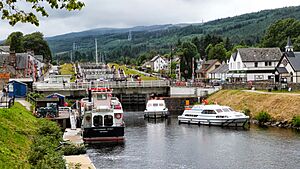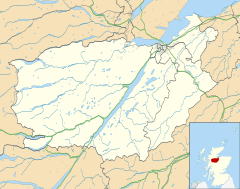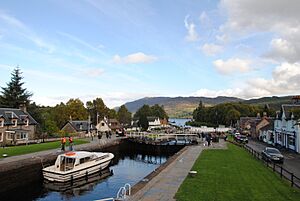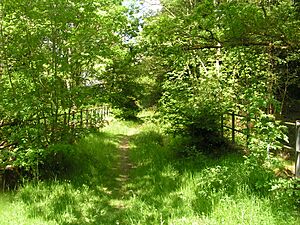Fort Augustus facts for kids
Quick facts for kids Fort Augustus
|
|
|---|---|
 Swing bridge and locks at Fort Augustus |
|
| Population | 620 (2020) |
| OS grid reference | NH379090 |
| • Edinburgh | 100 mi (161 km) |
| • London | 430 mi (692 km) |
| Council area | |
| Country | Scotland |
| Sovereign state | United Kingdom |
| Post town | Fort Augustus |
| Postcode district | PH32 |
| Dialling code | 01320 |
| Police | Northern |
| Fire | Highlands and Islands |
| Ambulance | Scottish |
| EU Parliament | Scotland |
| UK Parliament |
|
| Scottish Parliament |
|
Fort Augustus is a small village in the Scottish Highlands. It is located at the southwest end of Loch Ness. The village is a popular spot for visitors. Tourism is very important for the people who live here.
Contents
A Look at Fort Augustus's Past
The village was once called Kiliwhimin. Its name in Scottish Gaelic is Cille Chuimein. This name likely came from Saint Cumméne Find of Iona. He built a church in the area a long time ago.
After a big event called the Jacobite rising of 1715, the village's name changed. General Wade built a fort here between 1729 and 1742. He named it after Prince William, Duke of Cumberland. The village then grew around this new fort and took its name. In March 1746, the Jacobites took control of the fort. This happened just before the famous Battle of Culloden.
In 1767, some old Roman coins were found near an ancient abbey. These coins were from a very long time ago, between 79 AD and 560 AD.
Later, in 1867, the fort was sold to the Lovat family. They then gave the land to a group of monks called the Benedictine order in 1876. The monks built Fort Augustus Abbey and a school there. The school closed in 1993 because fewer students were joining. The site was then used as a heritage center for a few years. In 1998, the monks left the site. It was later sold to Terry Nutkins.
Getting Around Fort Augustus
Fort Augustus is located on the A82 road. It is about halfway between the cities of Inverness and Fort William.
The village once had a train line. It ran from Spean Bridge to a station on the banks of Loch Ness. This railway operated from 1903 until 1933.
The Caledonian Canal also runs through Fort Augustus. This canal connects Fort William to Inverness. It has a series of locks in the village that help boats move up and down to Loch Ness.
Community and Education
Fort Augustus has a medical center called Cill Chuimein Medical Centre.
The village also has schools for children. Both Kilchuimen Primary School and Kilchuimen Academy share a campus.
Fort Augustus Weather
Fort Augustus has a mild climate, like most of Britain. Summers are cool, and winters are not too cold. The area does not get a lot of sunshine, usually around 1,000 hours each year.
Temperatures can be surprising. Fort Augustus holds the record for the lowest May temperature in the UK, which was -9.4°C. This means it can get very cold even close to summer. However, because it's in a valley, it can also get quite warm sometimes. Fort Augustus once held the UK record for the highest temperature on December 16th for almost 80 years.
Notable People from Fort Augustus
- Guy Prendergast (1905–1986) was an explorer and soldier. He is buried in Strathoich cemetery.
See also
 In Spanish: Fort Augustus para niños
In Spanish: Fort Augustus para niños




